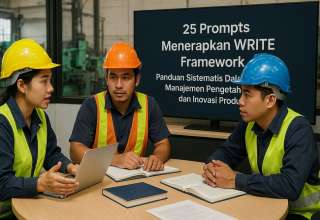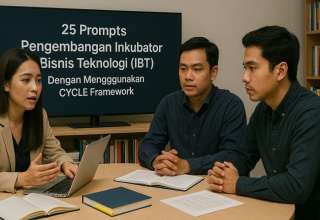
*) Gambar sebagai ilustrasi
System Development Lifecycle (SDLC) Using SYSTEM Framework
By: Mohamad Haitan Rachman, INOSI
Please use The SYSTEM Builder GPT: https://chatgpt.com/g/g-6857336737c48191baed5baede8b390d-system-builder-gpt
This customized SDLC integrates the six pillars of the SYSTEM Framework — Structured, Yielding, Strategic, Technology, Empowered, and Management — into every phase of the lifecycle. It ensures that each step in system development is technically sound, user-centered, and strategically aligned.
Overview of SYSTEM-Based SDLC
| Phase | SYSTEM Component Focus | Purpose |
|---|---|---|
| 1. Needs Analysis | Strategic, Empowered | Identify goals, align with vision, engage stakeholders |
| 2. System Planning & Scoping | Structured, Strategic | Define scope, architecture, roles, roadmap |
| 3. Design & Prototyping | Structured, Empowered | Create models, mockups, interfaces, and workflows |
| 4. Technology Development | Technology, Structured | Code system functions, integrate platforms, apply standards |
| 5. Testing & Quality Control | Yielding, Technology | Ensure system accuracy, usability, security, and KPI readiness |
| 6. Deployment & Training | Empowered, Technology | Launch system, onboard users, and transfer knowledge |
| 7. Performance Management | Yielding, Management | Monitor outputs, user feedback, and system usage |
| 8. Evaluation & Iteration | Management, Strategic | Reflect, review, adapt system for continuous improvement |
Phase-by-Phase Breakdown
1. Needs Analysis
Focus: Strategic, Empowered
Objectives:
- Understand business challenges and opportunities.
- Align system with organizational strategy.
- Involve stakeholders early.
Activities:
- Conduct stakeholder interviews and surveys.
- Perform SWOT/PESTLE analysis.
- Define high-level goals and outcomes.
2. System Planning & Scoping
Focus: Structured, Strategic
Objectives:
- Define system boundaries and structure.
- Translate needs into system requirements.
- Create the system blueprint.
Activities:
- Develop functional and non-functional requirements.
- Design WBS (Work Breakdown Structure).
- Create a development roadmap and timeline.
3. Design & Prototyping
Focus: Structured, Empowered
Objectives:
- Visualize the system.
- Involve users in the design process.
Activities:
- Create ERD (Entity Relationship Diagram) and system flow diagrams.
- Build wireframes or UI/UX prototypes.
- Facilitate user reviews and feedback sessions.
4. Technology Development
Focus: Technology, Structured
Objectives:
- Build and integrate the system components.
- Ensure code quality, security, and scalability.
Activities:
- Develop front-end and back-end modules.
- Integrate with APIs, databases, and third-party services.
- Conduct internal unit testing and documentation.
5. Testing & Quality Control
Focus: Yielding, Technology
Objectives:
- Validate system performance, usability, and compliance.
- Identify bugs, errors, and inconsistencies.
Activities:
- Execute functional, security, and performance tests.
- Conduct UAT (User Acceptance Testing).
- Finalize technical documentation.
6. Deployment & Training
Focus: Empowered, Technology
Objectives:
- Deploy the system effectively.
- Ensure users are trained and confident to use the system.
Activities:
- Roll out the system in production.
- Conduct training workshops or e-learning sessions.
- Develop help guides, FAQs, and user manuals.
7. Performance Management
Focus: Yielding, Management
Objectives:
- Track system usage and performance against KPIs.
- Measure value creation and ROI.
Activities:
- Implement monitoring tools and dashboards.
- Collect real-time feedback and usage logs.
- Generate periodic performance reports.
8. Evaluation & Iteration
Focus: Management, Strategic
Objectives:
- Review system effectiveness and user satisfaction.
- Apply lessons learned for future iterations.
Activities:
- Conduct project review and retrospective.
- Identify gaps and opportunities for improvement.
- Plan for updates, feature extensions, or scaling.
Key Features of SYSTEM-Based SDLC
| Feature | Description |
|---|---|
| Strategic Alignment | Ensures the system supports long-term goals. |
| Human-Centered Design | Engages users throughout for empowerment and usability. |
| Technology-Driven Execution | Utilizes scalable, secure, and modern tools and platforms. |
| Result-Oriented Monitoring | Measures system success through defined KPIs and real-time feedback. |
| Sustainable Management | Promotes maintainability, governance, and lifecycle continuity. |
Benefits of SYSTEM-Based SDLC
- End-to-end lifecycle guidance – from ideation to continuous improvement.
- Balanced between people, process, and platform.
- Customizable for Agile, Waterfall, or Hybrid methodologies.
- Scalable for small, medium, or enterprise-level systems.
- Applicable across industries — education, finance, healthcare, government, etc.
Final Note
The SYSTEM Framework doesn’t just shape what you build — it shapes how and why you build it. Applying this lifecycle model ensures that system development is strategic, measurable, scalable, people-centered, and sustainably managed.
If you have questions related to writing, designing, developing, and training systems and wish to collaborate, please contact us at haitan.rachman@inosi.co.id.










